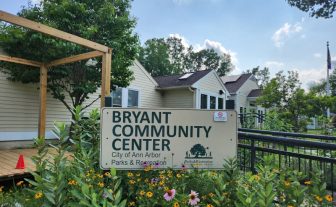By Elinor Epperson

Bryant Community Center is run by Community Action Network in partnership with the city of Ann Arbor, Michigan. The center’s solar power system is part of the agency’s growing renewable energy projects in the city’s underserved communities. Image: Elinor Epperson
Ann Arbor proposed sustainable energy utility could save residents and commercial customers money on their electricity bills, according to a new report commissioned by the city.
Residents of the Southeast Michigan city will vote in November on whether to establish an optional public utility that would use exclusively renewable energy generated by local systems. The project is part of its A2Zero program, which aims for carbon neutrality by 2030.
If the proposal passes, it will be the first sustainable energy utility in Michigan. Similar utilities have operated in Delaware since 2007 and Washington D.C. since 2011.
The report calculated cost savings based on how much it will cost the city to set up the utility and how many customers participate in the utility. Estimates are for 2028 and 2038 to account for the time it will take to get the utility up and running.
Residents could save on their electricity bills by opting in to the utility, according to the report.
Missy Stults, the director of the city’s sustainability office, said the more people who opt-in to the utility, the lower energy rates will be.
“We want to make sure that we have kind of a critical mass of people interested in the sustainable energy utility to start, so that rates really are cheaper,” she said. Savings will be low in the beginning as the utility gets off the ground, but should increase the longer it operates, the report said.
The project’s biggest priorities are generating renewable energy and sharing it, all on the local level, Stults said.
“That’s different than how the grid works today,” she said. Currently, power provided by a large utility company is generated in a few central locations, then distributed across long distances. A lot of the weaknesses in the current power grid are in the distribution system of wires, transformers and towers that are vulnerable to extreme weather.
Unlike a full-scale public utility, the sustainable utility proposed would be supplemental. Residents and businesses would need to opt-in to use it.
“It is not a total takeover of existing assets,” Stults said. Customers would still receive power from DTE Energy, the area’s electricity and gas provider.
Michigan law prohibits private citizens from transferring power across property lines. Creating the public utility would comply with that law and allow private homes that join it to share the energy they generate with neighbors, as well as with community solar projects created by the city.
Community solar is a publicly-owned solar power system that residents can invest in one or two panels at a time. It’s a more affordable option than installing an entire system, which can cost $10,000 to $30,000 up front.
It also allows renters to invest in renewable energy. They would need to get the property owner’s permission, but if a property opts into the utility, whoever is responsible for paying electricity bills would pay the renewable utility rates.
Accessibility for low-income residents is also a priority for the city, Stults said.
Derrick Miller, the executive director of Community Action Network in Ann Arbor, said a sustainable energy utility would save low-income residents money in the long run.
“This is a very high-energy burden community, meaning that a large percentage of their total income goes towards utility expenses,” he said.
Community Action Network provides food, housing and economic assistance for underserved neighborhoods. That includes installing energy-efficient upgrades, like high-efficiency appliances, better insulation and solar panels.
Using locally generated renewable energy would also increase resilience, Miller said. Extended power outages can cost families money from lost food and property damage. Connecting those homes as part of a sustainable energy utility would create a local microgrid that could shorten or eliminate power outages.
Stults said she hopes the project can lay the groundwork for other Michigan communities to invest in publicly owned renewable energy.
“It would not be a success to us if we figure out how to run an SEU or to become carbon neutral, which is our ultimate goal, if we do it in a way that’s not replicable,” she said.
The proposal is an opportunity for Ann Arbor to pioneer a new utility structure and learn from its mistakes, so other communities don’t have to, she said.
Other Michigan communities are keeping tabs on Ann Arbor’s progress, Stults said but declined to name them “because I’m not sure what kind of reaction they may get from the incumbent utilities.”
While cities can create their own public utilities, it is unclear if the state law allows counties and townships to do so as well, Stults said.
“That’s going to have to be tested,” she said.
If approved, Miller said the city’s public utility would give residents a bigger say in how they get their energy.
“It gives a lot more ownership and input from the actual residents that are partaking in the [renewable utility],” he said. “And that is completely the opposite with the current utility framework.”
Elinor Epperson has an environmental reporting internship under the MSU Knight Center for Environmental Journalism’s diversity reporting partnership with the Mott News Collaborative. This story was produced for Michigan Public.